
by Osprey Photo Workshops & Tours | Mar 19, 2022 | Bird photography, Nature Photography, Pennsylvania, Photo Workshops, Snow Geese, Swans, Wildlife Photography, Winter Photography

Snow geese lift off at Middle Creek Wildlife Management Area.
Middle Creek Wildlife Management Area, PA
At the beginning of March I spent a day and a half at Middle Creek Wildlife Management Area in Pennsylvania, approximately a 2.5 hour drive from my home near Baltimore. This was my first visit to the area. I could not resist packing up my camera gear and heading north when a friend from one of my photo workshops sent me a great image she had just taken at Middle Creek of a huge flock of snow geese taking off from a farm field.
Many years ago, 40,000 snow geese visited Chincoteague National Wildlife Refuge in November. I recall one afternoon during one of my photo workshops, while driving the Wildlife Loop we encountered thousands of snow geese in the impoundment and near the road. Periodically they would rise in unison from the ground sounding like a plane taking off. They would fly overhead, circle, and return to the same spot that they had left. Not only did they do this once, but repeated the behavior several times more. I have never forgotten that day. But in recent years the number of geese at Chincoteague has dropped dramatically. Many are now spending the winter at Bombay Hook and Prime Hook National Wildlife Refuges in Delaware with the geese feeding in the fields of the Delmarva Peninsula. It is reported, seasonal counts have exceeded 200,000.
At Middle Creek, I was a reminded of the past scenes at Chincoteague but with even more birds. During my visit on March 4th, there were 78,000 snow geese present with nearly 3,000 tundra swans. Periodically, the number of birds present in the winter were as high as 200,000.

Middle Creek Wildlife Management Area, PA
Middle Creek Wildlife Management Area is located on the boarder of Lebanon and Lancaster Counties in Pennsylvania, north of the town of Lancaster in the middle of Amish Country. Middle Creek is operated by the Pennsylvania Game Commission which is in charge of managing the wild bird and mammal populations at Middle Creek. This roughly 6000-acre wildlife management area is home to hundreds of species of birds and mammals. It is crucial for the hundreds of thousands of ducks, geese, and swans that visit during their spring and fall migration.
A number of accommodations are available approximately 20-25 minutes from Middle Creek at the towns of Ephrata and Lititz, PA.

Middle Creek Wildlife Management Area, PA
At Middle Creek there is a Visitors Center with interpretive displays, an auditorium, and an observation area with feeders and views of Middle Creek Lake. Also there are a number of walking trails, several picnic areas, a vehicle tour loop, and areas set aside for fishing and hunting. During the peak of the fall migration of waterfowl, to reduce disturbance of the birds, portions of the tour loop are closed to vehicles. However, from 1 March until 30 September, vehicles are permitted on the interior, northern part of the tour route.

The Lake
The impoundment (lake) where the snow geese, tundra swans, and other waterfowl congregate was created by the construction of a dam in the early 1970s. It is quite shallow, with an average depth of only three feet. Waterfowl attracted to the lake are those that prefer shallow water, compared to the diving ducks of the Chesapeake Bay. The deepest part of the lake is just above the dam where you might see herons, egrets and kingfishers.

Visitors Center Pond
The Visitors Center pond during the spring and fall migrations is an excellent spot to observe at a distance mallards, black ducks, northern shovelers, ring-necked ducks, wood ducks, hooded mergansers and others. The “tree-house” type structure located behind the pond is a bat condominium intended to serve as a maternal colony for up to 6,000 bats.

Kleinfeltersville Rd
Just past the road to the Visitor Center along Kleinfeltersville Rd on the right is an open area with a relatively clear view of the lake. When I was there, the cove was filled with snow geese in the morning and evening, with some at close range. They shared the area with Tundra Swans.At times more geese joined the group filling the sky with birds before landing. Eventually the main group of geese flushed and in mass, joined the other geese farther back in lake. To my surprise, the swans did not join them.. It may be a good spot to photograph flying geese at sunrise. However, most visitors gather at Willow Point for sunrise.


Willow Point Trail
The Willow Point Trail is very popular when the geese are present. It is an easy 10-minute paved walk that leads visitors to an observation point overlooking a large portion of the 360-acre lake. During spring migration, there are days when the waterfowl put on incredible flight displays, moving from one section of the lake to another. Occasionally, they would fly over the head of visitors before circling back to the lake. It was suggested that they took off in response to a bald eagle that left its perch on a dead tree across the lake and headed towards the flock.


Waterfowl Propagation Areas
From the Observation Point Parking Lot past Willow Point, it is possible to see activity within the waterfowl propagation area which is off limits to people. It is set aside to allow birds a place to nest, rest and feed unmolested year-round. In the spring and early summer you may see a variety of songbirds. Bird boxes attract tree swallows and bluebirds. In the fields you may see bobolinks.
On the southwestern portion of the lake there are three different types of nesting structures provided for waterfowl. Tire and tub structures provide a nesting areas for Canada geese. The straw tubes are provided for mallards and black ducks, while the box style structures are for wood ducks.



View from the interior loop road.
After observing the movement of geese from Willow Point and talking to other photographers, on my last afternoon in the area, I drove to the northern end of the interior tour loop where I thought the geese might be landing in a field close to the road. There were a number of cars parked at the side of the road which suggested I was right. I left may car at the end of the line and walked to where I had a clear view of the field and a number of geese on the ground. As I stood there photographing, other geese left the lake and joined the group. More and more geese arrived with some on the ground taking off and flying overhead to a field behind me. As sunset approached, the parade of geese leaving the lake continued with one “V” formation after another heading in my direction. I had hoped they would pass in front of where the sun was setting but most did not. However, I did capture a few images of lines of geese in front of the warm colors in the sky.


I plan to return in future years. Great wildlife photography opportunities.

by Osprey Photo Workshops & Tours | Aug 9, 2021 | Bird behavior, Bird photography, Chicoteague, Digital Photography, Nature Photography, Photo Tours, Photo Workshops, Rookery, Spring Photography, Spring Photography, Spring Photography, Wetlands, Wildlife Photography
May/June 2021- Heron Rookery Photo Project

From 24 April until 18 June 2021 I was on the road. One of my projects involved documenting the activity in a heron colony populated by a variety of wading birds–Great and Snowy Egrets, Black-Crowned Night Herons, Tri-color & Little Blue Herons, and a few Glossy Ibis. The rookery was in a large marsh on a ridge where low shrubs grow such as Bayberry and Wax Myrtle. Nests were low and among tangled branches that help protect the nests, eggs, and offspring from predators. It was a perfect locations with little chance of flooding and rich waters nearby with abundant food to provide for the growing youngsters.
Photographing colonial birds in a rookery setting requires a very careful approach as to not negatively effect breeding success.
Herring Gulls
Surrounding the heron colony in the tall stands of salt-meadow hay Herring Gulls nested. They chose a perfect location since they could swoop over the rookery harassing the herons and attempting to grab eggs and hatchlings. On several occasions, I saw a gull dive down and hit exposed heron. There was evidence that high water flooded the lower part of the marsh and destroyed some of the nests.


Precautions
I took great care to minimize any disturbance of the nesting birds to avoid interfering with nesting behavior, possibly causing displacement of eggs or the herons abandoning nests. I keep. my visits infrequent, limited in time, and when temperatures were moderate. Since my intent was to document natural behavior and interactions between individuals, I would have been foolish and unethical to disturb the birds.
My route through the marsh was difficult since I had to avoid soft mud, holes, and tidal guts. I benefited from past experience reading the marsh and noting what grasses and substrate would support me.
Dressed in camouflage, I approached the colony slowly and indirectly. I photographed from a low position, sitting or kneeling on the soggy, water-saturated ground. Once in place, I minimized my movement. It was usually distant noise that would cause the birds to flush from their nests -- the rumble of trucks, planes, boats, and construction projects.. Luckily, the birds quickly returned to their nests and young.

Equipment
Lenses primarily used included my 200-500 mm and 80-400 mm Nikon lenses.with my D500 and D850 Nikon cameras attached. The telephotos were necessary to keep my distance from my subjects and yet isolate them. Zoom lenses provided for flexibility. As the birds moved and interacted, I could adjust my focal length to capture the range of motion. Most shots were taken using a tripod with a sturdy ball head or gimbal mount. I used waterproof sleeves over the base of the tripod legs to protect the joints from damaging grit and corrosive brackish water.


Changes from May into June
During May, many herons displayed breeding plumage and bright colors around the eyes and bill. A few still were engaged in mating, courting and nest building, with some birds carrying sticks. In mid-June, courtship feathers were less obvious and the facial colors had faded a bit. There were eggs in some nests and young birds in others.


Capturing action
One of my goals was to capture arial fighting and aggressive behavior as birds landed in the bushes and jockeyed for position to access their nests. I carefully observed the colony concentrating on areas where there was more activity and less tolerant birds. Aggressive actions included nipping, stabbing, feather pulling, hackle raising, or just landing on the back of an opponent.
I had the best luck capturing the arial fights when using my 80 – 400 mm lens and shorter focal lengths since it was nearly impossible to predict exactly where and when the action would occur.



Focus Difficulties
If the birds were flying with sky in the background, I focused using a small group of focus sensors. When multiple subjects were involved, I selected an f-stop that offered a bit more depth of field than usual such as an F11 or 16. But to freeze action with high shutter speeds, I had to use higher ISOs than I typically prefer (often 1000 or 1250). When the birds were perched on branches or were landing, I often used a single focus point over the bird's eye.
With auto focus, I had problems with the sensor locking on branches and leaves, not the bird. Sometimes manual focus was required. Because the nest were located deep within shrubs, I struggled to get clear shots of the birds landing and interacting without branches, grass, shadows or the wings blocking their faces.

Final Thoughts
Most folks find marsh foreboding with muck, unpleasant smells, and pesky flies and mosquitoes. For me, they are marvelous places filled life and new things to discover. When involved with projects like this one where I am deep within a marsh, I find solace and a connection with nature.
Marshes are critical ecosystems that need our protection, not destruction They are highly productive and a haven for wildlife. They trap sediments and remove nutrients and toxins from the water that can clog our waterways, poison wildlife, and deplete life-giving oxygen.

by Osprey Photo Workshops & Tours | Aug 8, 2021 | Autumn photography, Chincoteague NWR, Nature, Nature Photography, Photo Tours, Photo Workshops, Wildlife, Wildlife Photography
Trip Report, Chincoteague NWR, November 2020
Nature Photography
Chincoteague NWR is located on the southern Virginia end of the barrier island of Assateague. In the fall, the refuge attracts large numbers of snow geese along with ducks, swans, herons, ospreys, shorebirds and other migrants. It is also the home to wild horses, deer, raccoon, fox squirrels, and other animals. Used to being protected, the wildlife is unusually tolerant of humans and presents visitors with great photo opportunities. It is one of my favorite places to photograph wildlife in both the fall and spring. I have been conducting photo workshops there for many years. Numbers of species and the variety has shifted over the years. The refuge is located along the Atlantic Flyway. Once over 40,000 snow geese stopped at the refuge doing fall migration Now they stop farther north but still several thousands visit the refuge today along with shorebirds, swans, and other waterfowl.


Chincoteague NWR website:
https://www.fws.gov/refuge/chincoteague/
Trip report – Fall 2020
First Stop – Sunrise
For sunrise I typically stop along Beach Road at the first large pool on the right after passing the visitors center– Black Duck Pool. There are convenient pull offs for cars on both sides of the road. At sunrise, I often see deer crossing the water.
I had a treat one morning at sunrise when a large flock of White Ibis circled overhead with many landing in front of me. They were joined by herons and a few ducks. When photographing the birds against colored sky and water, I had to be careful that their silhouettes did not merge with the silhouettes of other birds or the surrounding grasses.
Several mornings were foggy and allowed me to create images different from many I have taken here before at this location. The two photos below were taken on one of those mornings. I like the layers revealed by the lifting fog and sense of calm these images invoke. In terms of exposure if using aperture priority, I had to increase my exposure compensation by at least +2. Remember that the light meter assumes it is pointed at something mid-tone and will darken the exposure to make it so, thereby underexposing the image.


First Stop – Sunrise
For sunrise I typically stop along Beach Road at the first large pool on the right after passing the visitors center– Black Duck Pool. There are convenient pull offs for cars on both sides of the road. At sunrise, I often see deer crossing the water.
I had a treat one morning at sunrise when a large flock of White Ibis circled overhead with many landing in front of me. They were joined by herons and a few ducks. When photographing the birds against colored sky and water, I had to be careful that their silhouettes did not merge with the silhouettes of other birds or the surrounding grasses.
Several mornings were foggy and allowed me to create images different from many I have taken here before at this location. The two photos below were taken on one of those mornings. I like the layers revealed by the lifting fog and sense of calm these images invoke.

In terms of exposure if using aperture priority, I had to increase my exposure compensation by at least +2. Remember that the light meter assumes it is pointed at something mid-tone and will darken the exposure to make it so, thereby underexposing the image.

Black Duck Pool
After shooting sunrise, I will check out the scene across the road for horses and herons in the early morning light. If there is nothing of interest, I typically drive towards the beach checking out the borrow ditches on the side of the road for herons, ducks and other visitor that are in good light and in a suitable non-distractive background.
Note: In the summer it is difficult to photograph wildlife other than in the early morning and late in the pm since there is a lot of traffic on Beach Road as folks head to the public beach for the day.
On the morning that I saw the flock of ibis at sunrise, I found a large number of individuals engaging in a feeding frenzy at the junction between the borrow ditch on the left and Swan Cove. They were joined by a few herons. This is the first time that I have witnessed such a high number of ibis together. When they finished feeding in one area, they moved up the borrow ditch congregating at various points along the way. My car worked beautifully as a mobile blind. I could move the car and follow the birds as they traveled upstream. I shot from the car as to not disturb the birds and used a bean bag on the window sill to securely support my lens and camera.

Occasionally in the same area I have encountered a fox or raccoon, so I am always checking the edges of the road for cooperative subjects.

Swan Cove
One of my favorite spots to photograph is Swan Cove. It typically attracts are large number of birds including shorebirds that often feed in the shallows near the road at low tide. On this trip I encountered a group of Yellowlegs and Dowitchers feeding close to the shore. Again I used my car as a mobile blind, shooting from the window with my 600 mm lens mounted on my home-made beanbag. On a day there was little wind and I was able to capture images of the birds with their reflection in the water. I always look for small ducks and grebes in this pool. On this trip I was able to photograph several tolerant Pied-Billed Grebes, Buffleheads and Ruddy Ducks close to shore, sleeping, preening and diving for food.


Black Duck Pond
Often later in the morning I check out the marsh and fields across from Black Duck Pond. I typically look for horses in the marsh and around small stands of trees. Around 9 a.m. on more than one morning, I got a number of photos as the horses crossed the marsh and fed on the grasses. Sometimes blackbirds would land on their backs, I am guessing, eating insects.

In this same area I found a cooperative female Belted Kingfisher sitting on a post. I spent a delightful hour with her as she flewdown to catch fish, landed on the post again, shook off water, preened. and stretched its wings. I got a number of great images shooting from my car with my 600 mm F4 lens combined with a 1.4 teleconverter



Also in the same marsh where there were pools of water and a channel, I was able to photograph herons feeding, groups of Buffleheads swimming the channel as well as Double-crested Cormorants swimming, diving or sitting on dead snags drying their wings. This past year the water level in the marsh was perfect for shooting across marsh at sunset.

Little Toms Cove
I frequently check out this area near the water control devices that allow water to pass under the road to Swan Cove. Often when you have an obstruction in waterway, macroinvertebrates and other organisms accumulate around the opening often attracting fish and birds. This year I encountered a bird that I had not photographed before, a Surf Scoter, a sea duck typically seen flying over the ocean. This past November there was a Horned Grebe hanging out in the same location. When the tide is out, I often see rails or oystercatchers feeding on the exposed mud flats.


Sea Ducks
In the winter some photographers go to Barnegat Light and State Park in New Jersey, The photographers brave the cold to photograph sea ducks from the jetty at the inlet — a favorite is the Harlequin Duck. I have not visited the site in the winter but have seen great results. However, conditions can be dangerous with icy rocks and a rough surf with waves that might swamp you and your equipment.
 Atlantic Shore
Atlantic Shore
I always check out the beach for a colorful sunrise or shorebirds feeding along the water’s edge. The best time to photography is when the tide is low and when more of the beach is exposed. When photographing shorebirds, in the morning at Chincoteague it is difficult to avoid shadows covering much of the bird without moving out into the surf. However with post processing in Lightroom and Camera Raw, you can lighten the shadows with a selection brush. I always concentrate on birds that are moving towards me, not retreating. In the afternoon, it is easier to capture these images since the bird often is lit by the soft warm light at the end of the day.


 x
x
Bayside
On the bayside of Little Toms Cove opposite the beach, I often find an assortment of shorebirds, herons and an occasional fox. On this visit, there were Great Egrets flying back and forth feeding near posts marking private clam beds. I also photographed aa Black-bellied Plover and a Dunlin in winter plumage feeding amongst the oddly colored organism called Sea Pork. It is a colony of tunicate organisms which are plankton feeders. Though an oral siphon, they draw seawater through their bodies and pass it through a sieve-like structure that traps food particles and oxygen, eventually to exit through the atrial siphon. One sunset when the tide was out, I captured the remarkable colors and patterns as the setting sun lite the mud flats.



Wildlife Loop
On fall afternoons, I often checked out the wildlife drive around Snow Goose Pool (only open to cars after 3 pm). This time not long after I entered the drive, I saw a flock of ducks explode in flight from the marsh. It took me a minute to realize that a bald eagle had swooped over the group. It missed catching a duck and flew back to the pine tree where it often perched near its nest. Unfortunately, I was distracted by the ducks, I missed the shot of the eagle. On other trips I have seen a pair of eagles siting on the edge of the marsh in the same area. Northern Harrier (Marsh Hawks) also hunt in the area.


Shoveler Pool
Farther around the Wildlife Loop is Shoveler Pool which typically attracts ducks, geese, and swans. I was not disappointed this year for small groups of Pintail Duck, Green-wing Teal and Black Ducks took off and landed in the pool. Each day there were a number of Tundra Swans resting and feeding in the same area. Some individuals were quite aggressive, chasing geese and other swans. Before attacking, they often became very vocal, extending their necks low to the water and picking up speed. This fall the water level was low with weeds poking through the water’s surface, often leaving me with a somewhat distracting background behind the birds.
In the background of this pool was a stand of dead pines. These are Loblolly Pines which were killed by an infestation of Southern Bark Beetles that attack old or diseased trees. In several places in the refuge you will see similar stands of dead trunks. Refuge personnel replaces these dead pine trees with hardwoods such as red maple, water oak, and sassafras, creating a more varied habitat for wildlife. During your visit you may see young trees wrapped in plastic for protection.
If all goes well in May, I will return to Chincoteague NWR to photograph, hopefully to capture new and different images.




by Osprey Photo Workshops & Tours | Oct 7, 2020 | MD, Nature Photography, Photo instruction, Photo Technique, Photo Workshops, Wildlife, Wildlife Photography
My COVID 19 Quarantine Survival Story
With the emergence of the COVID 19 virus and the “Stay at Home Order”, like many people, I temporarily panicked. How long would the virus be an issue, two weeks, a month? I could deal that. But a year or more, I had no concept how I would emotionally and financially survive. Almost all my in-person speaking in engagements and photo workshops scheduled for the spring and summer had to be cancelled. Even my fall programs are in question.

Cardinal in spring
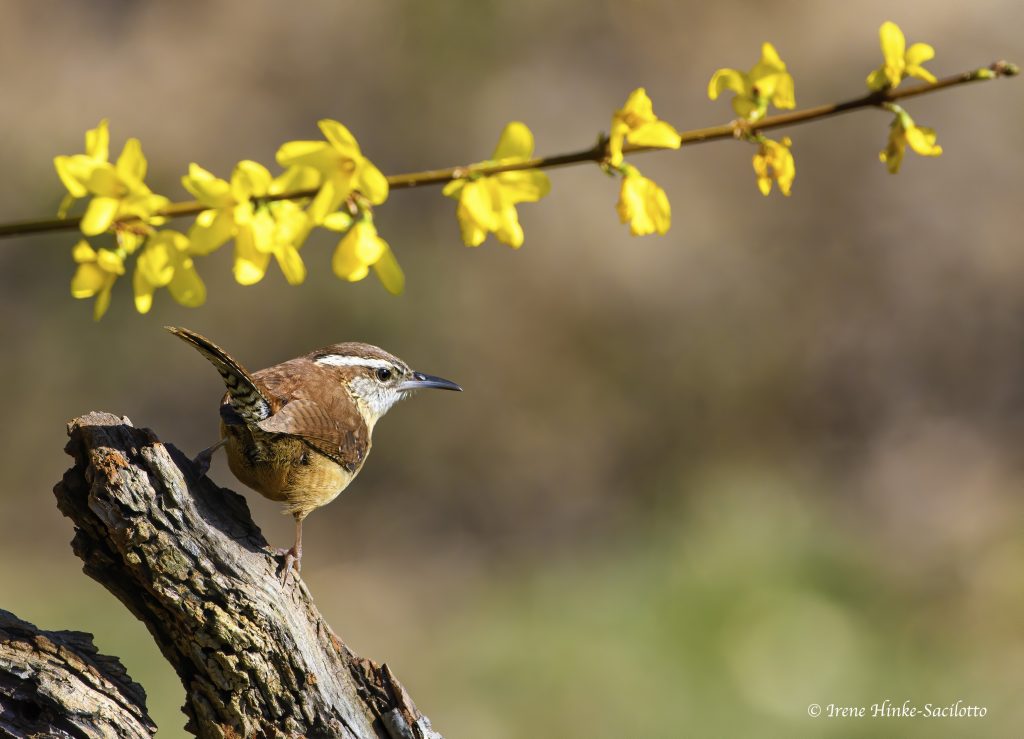
Carolina Wren photographed in local park attracted by feeder.
But I could not change conditions and was not financially destitute like many people, so I started to look for ways to turn this situation into a positive opportunity. I had plenty work to do on the computer—organizing and editing images, updating presentations, prepare advertising, producing a newsletter, etc. But I needed to be outside photographing at least part of the time. With no backyard where I could photograph, I decided to look for photo opportunities in my neighborhood. I checked out a number of trails and parks searching for non-crowded places with urban wildlife. Although some areas had limited possibilities, I did discover two gems.

Red-bellied Woodpecker landing on tree trunk.

Male Red-Bellied Woodpecker spotted when I heard it.
Initial Project:
At one park there was an osprey nest where I spent some time and I got the image above. Another park, five minutes from home, offered a number of opportunities to photograph squirrels, groundhogs, ospreys and an assortment of other birds. I created a feeder station in an open field near a line of shrubs. I baited the scene with birdseed, peanuts, suet and peanut butter. I added small evergreen branches and blooms from nearby trees for a natural looking environment. Squirrels and a variety of birds such as cardinals, wrens, sparrows, and grackles visited the site. Unfortunately, my setup disappeared when park maintenance workers unexpectedly cut the grass in the field. In addition, when the “Stay at Home Order” was issued, the park became a popular place to exercise. Many visitors came with huge bags of peanuts and bird seed which they liberally spread along the trails, attracting the resident squirrels for entertainment. With food everywhere, nothing came to my feeders. So, I had to find another location for photography.

Osprey with fish often head before seen.
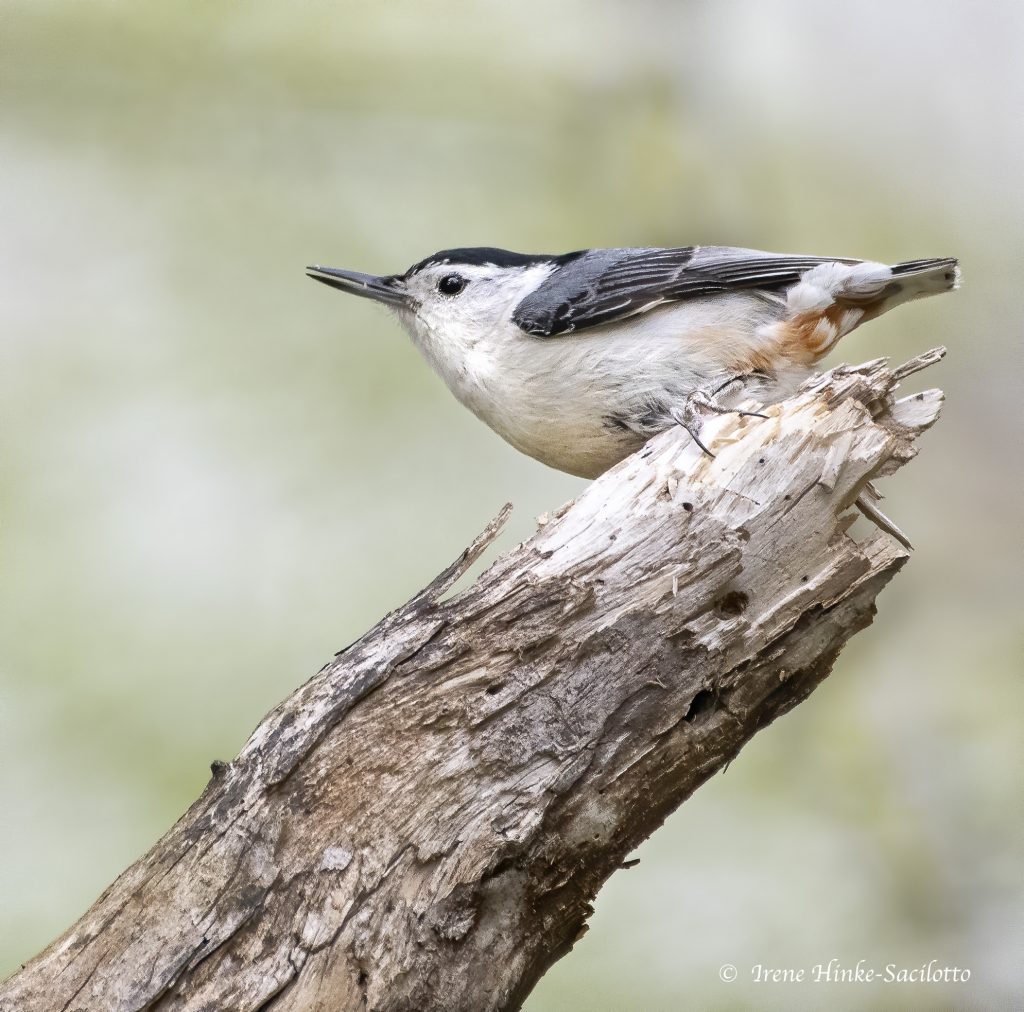
Nuthatch on branch in park.
2nd Project
Elsewhere in the park, I located a large old tree stump. It was adjacent to a path and as people passed by, they tossed peanuts and seeds on it attracting squirrels and also a variety of birds –chickadees, titmice, wrens, doves, blue jays, nuthatches, and red-bellied woodpeckers. To the scene, I added perches for the birds and some extra bird seed. I set up my tripod and camera just off of the path and was able to photograph a number of bird species. But more people kept coming to the park, making photography here more difficult.

Young Gray Squirrels in tree cavity.
3rd Project
While I was taking my daily walk for exercise, I discovered a tree cavity that was home to a family of young gray squirrels. I placed my tripod just off the path and for several days photograph the activity at the hole until the young squirrels outgrew their living quarters and left.

Young Gray Squirrel in tree cavity stretching.
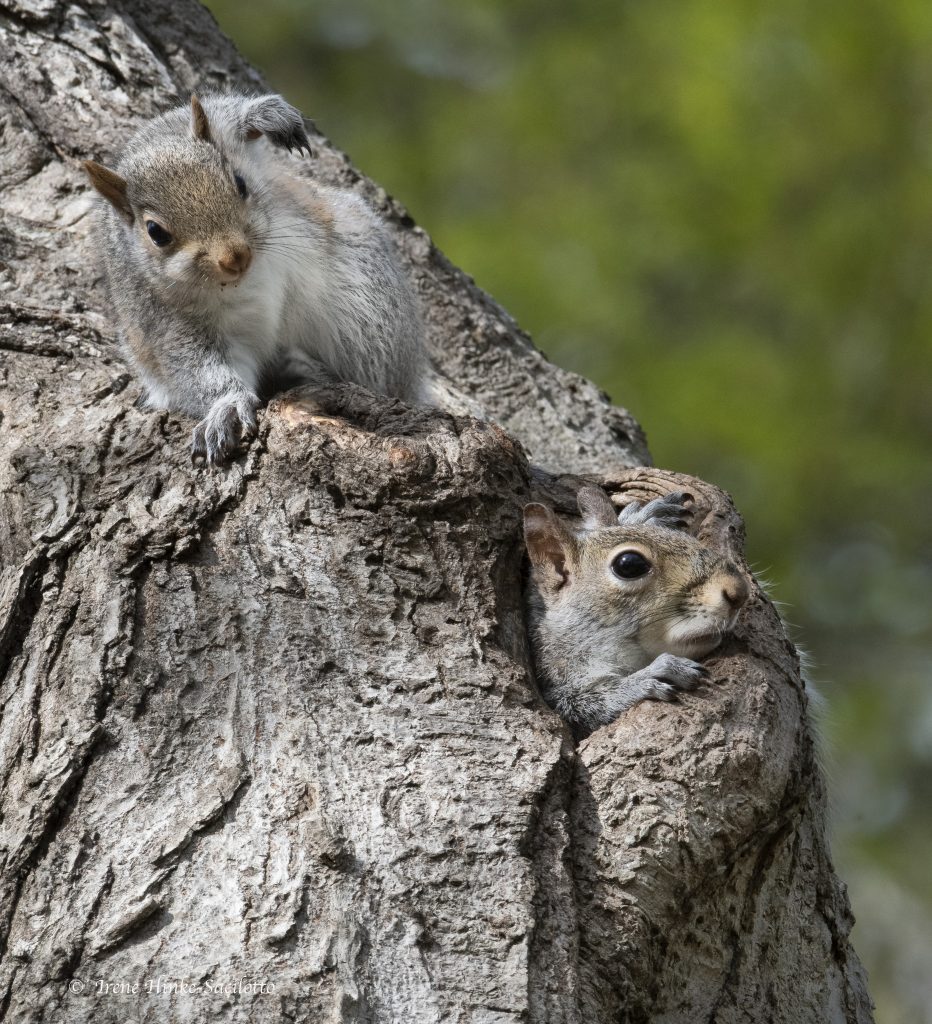
Young Gray Squirrels in cavity.
4th & Continuing Project
During the spring, I had reconnected with old friends. One living nearby owed several acres of land with an open field, a vegetable and flower garden, and woods. She is an animal lover and already had bird feeders at two locations in her yard. Better yet, on occasions, she saw foxes, groundhogs, and racoons from her porch. She was kind enough to allow me to photograph at her home and set up a blind. She loved seeing the resulting images. The experiences photographing at her house during June and July, and August will be covered in my next newsletter.

Pair of Black-capped Chickadees

by Osprey Photo Workshops & Tours | Oct 7, 2020 | Bird behavior, Bird photography, MD, Nature, Nature Photography, Photo instruction, Photo Technique, Photo Workshops, Uncategorized, Wildlife, Wildlife Photography
Urban Wildlife Photo Project
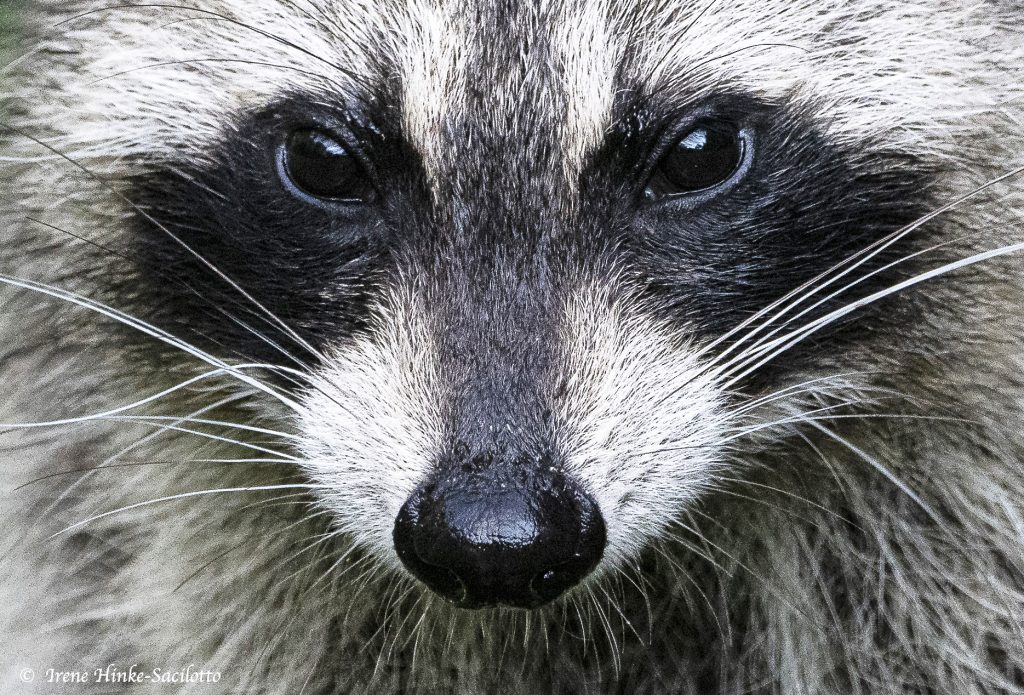
Raccoon Eyes
Overview
As mentioned in my last newsletter, in recent months I have reconnected with an old friend who has been allowing me to photograph on her property. She lives nearby and owns several acres of land with an open area, vegetable garden, flower beds, woods, and a pond by the house with aquatic plants, dragon flies and frogs. She has two permanent bird feeder locations that are near bushes and tall trees. One is located at the far end of the yard with the other near her house. Bushes and tall trees were nearby both. They provide cover from which the animals could safely approach the feeders as well as escape if threatened by hawks, foxes, or other predators. When the weather allowed from late April until today, I would spend several hours early in the morning or late in the afternoon photographing in her yard. In July when, temperatures soared into the mid to high 90s and humidity rose feeder activity slowed and was limited to the cooler times of the day and after sunset. The drop in activity seemed to continue into September.
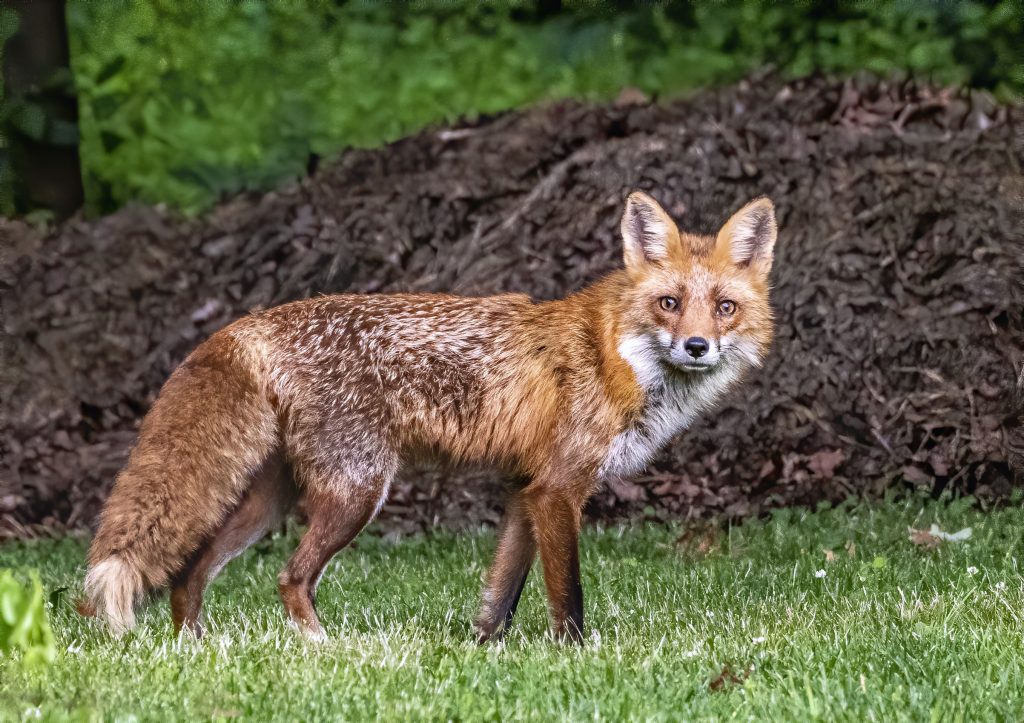
Red Fox emerging from woods.
Initial setup
In late April, I began photographing at the bird feeder nearest the house. It was close enough that I could photograph from my friend’s dining room window. In addition to standard bird seed and suet feeders, we hung a thistle sock on a branch to attract gold and purple finches. The non-melt suet, that could withstand the summer heat, attracted the small woodpeckers, chickadees, and nuthatches. At times we added meal worms to the mix, which seemed to be a favorite of the Carolina Wrens. The bird feeder at this location was elaborate with arms and multiple hooks from which to hang a variety of feeders. I added a few natural perches for the birds to land on, but to my disappointment, they seemed to prefer sitting on the iron appendages of the feeder stand. After several days shooting, I concluded that the way the sunlight hit the area was not ideal for it cast unwanted shadows on the birds. In addition, the bushes behind the feeders were very close making it difficult to blur the background even with the lens wide open and a shallow depth of field. It became even more distracting when hit by bright sunlight.

Raccoon eating apple put out to attract deer.
Second location
Adaptability, perseverance, and patience are all keys to successfully photographing animal behavior. When I failed to get satisfactory results at my first location, I shifted my attention to activity around the permanent feeder at the far end of the yard. Nearby, there was a bird bath and kiddy pool filled with water to attract wildlife on hot dry days. Since I did not want to photograph the birds at the feeder, I created what I have affectionately call my animal jungle jim. With logs, tree roots, branches, other items that I collected roadside and from nearby woods, I created a setup where I hung additional feeders and provided a safe place for the birds to perch. At key locations on the logs, I smeared peanut butter and suet. For the squirrels, raccoons, and jays, I added unsalted, raw peanuts to the wildlife buffet. After watching squirrels for an extended period of time, I am convinced that they are smart and agile and that very few bird feeders are squirrel-proof.

Black-capped Chickadee with the sun breaking through trees behind it.

Post to attract woodpeckers and the birds with suet block nearby.
Urban Wildlife Photo Project (cont.)
Periodically, I changed the arrangement to vary the background in my photos. For variety, I added a vertical 4-foot-long tree trunk cemented in a bucket that I could move to different locations. I baited it with a peanut butter/suet mix and placed a cage filled with suet nearby hoping woodpeckers and other birds would first perch on the trunk before jumping to the feeder. I added a small tree to the mix for birds to perch in, hoping to vary the appearance of my images.
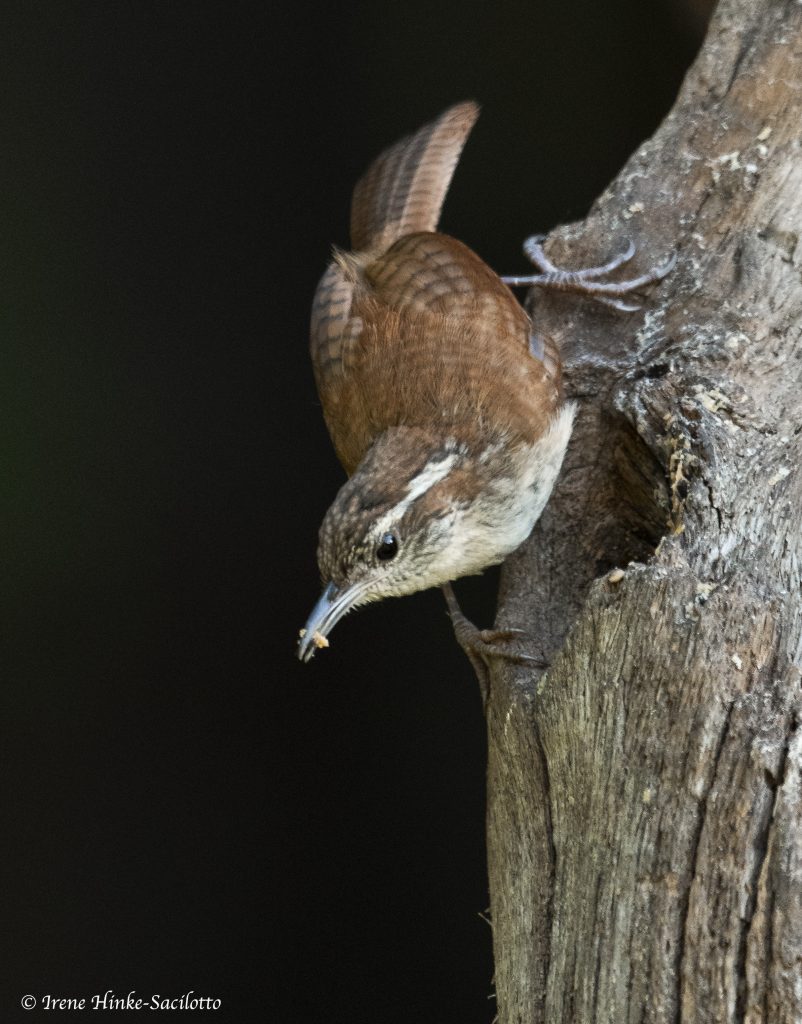
Carolina wren on post.

Downey woodpecker on side of tree trunk.

Frog escaping from backyard pond.
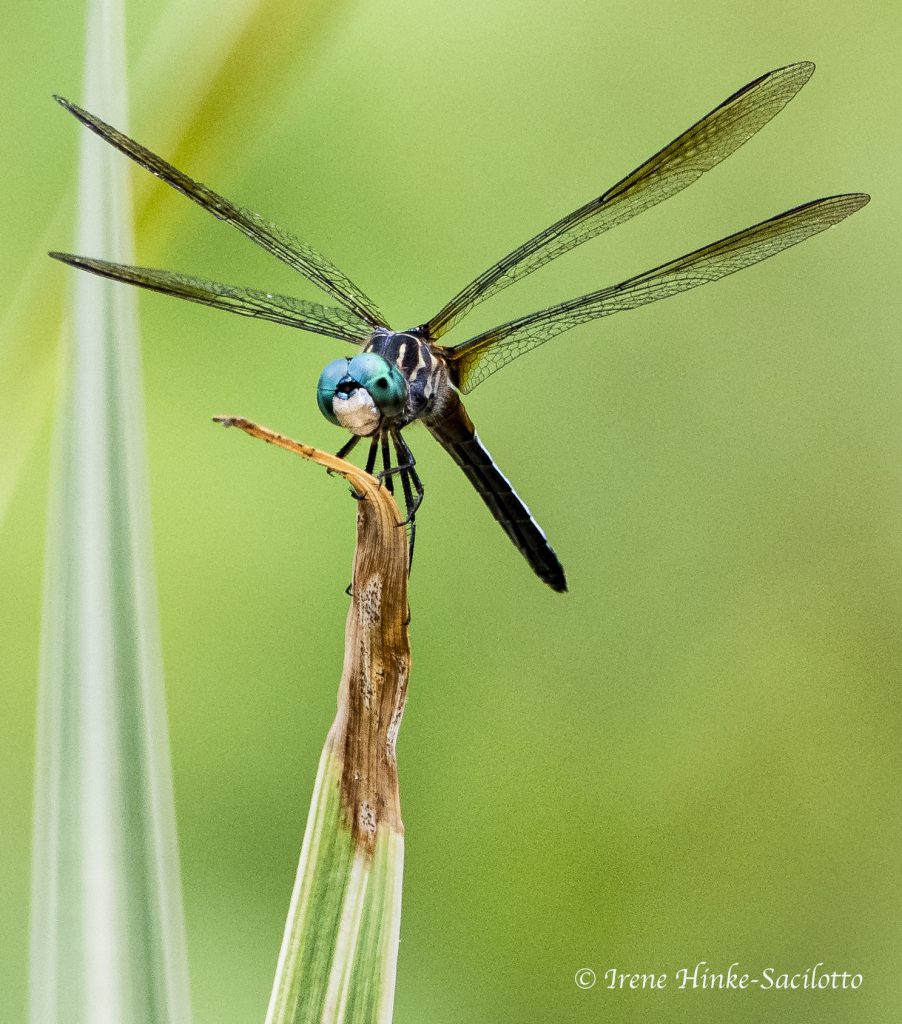
Dragonfly at pond
A couple days when activity at the feeders was low, I switched my attention to smaller subjects, dragonflies and frogs. But I only had my Nikon 200 to 500 mm lens with me instead of my 200 mm macro lens designed for close focusing. When I moved forward towards the subject to increase magnification to what I desired, the autofocus could not lock on it. Remembering a similar situation in the past, I switched to manual focus and discovered I could get closer to the subject and still keep it in focus. For the dragonfly, I had to avoid my shadow falling on it. I took advantage of the fact that if it flew away, it typically returned to the same spot. For the frog photos, I had to be careful to stay low and move slowly. The biggest problem was finding a camera angle where the background was satisfactory.

Gray squirrel peaking around tree trunk.

by Osprey Photo Workshops & Tours | Mar 23, 2020 | Bird behavior, Bird photography, Blue Heron Reclamation Wetlands, Florida, Florida's Atlantic Coast, Nature Photography, Orlando Wetlands, Photo Workshops, Waste Water Reclamation, Wetlands, Wildlife, Wildlife Photography

Florida Sandhill Cranes at Orlando Wetlands
This is Part 1 of a report on the photography along Florida’s East Coast.
The last two weeks of February I flew to the East Coast of Florida to scout for a future photo workshop in March of 2021 or 2022. In the past, I have conducted several workshops in Florida but on the west coast and in the Florida Everglades. This time, I spent 12 days visiting 18 locations along the east coast from St. Augustine to Boca Raton. Sites included wildlife refuges, state parks, zoos, gardens, and wastewater reclamation wetlands. I spent the majority of time at locations where wildlife was abundant and accessible. At other sites, I limited my visit to just enough time to evaluate the area for inclusion in a workshop.
Because of my busy lecture schedule, my visit was limited to late February. Even though it is a month earlier than I plan to offer a workshop, wintering birds were present and nesting was beginning. Breeding birds were carrying sticks, constructing nests, fighting over territory, mating, and displaying. Many wading birds displayed nuptial plumes and the color changes that come with breeding. In a few nests, chicks were present. In late March and early April, heron rookeries are much more active with screeching, hungry chicks and parents busy feeding in order to care for their young.

Sandhill Crane Feeding in field. Orlando Wetlands.

Snowy egret photographed at Orlando Wetlands
Two sites covered by this newsletter are Orlando Wetlands and Blue Heron Water Reclamation Facility and Wetland Area. These are natural and man-made wetlands fed by reclaimed wastewater, creating an environment beneficial to wildlife. Both are within a short drive from Titusville. Florida has a number of these sites with some open to visitation by birders and photographers and others are closed to the public. Some encourage visitation with boardwalks for easy access and viewing of wildlife. Several have bird rookeries within their boundaries.

Limpkin with snail at Orlando Wetlands.
What is reclaimed waste water? It is raw wastewater that has passed through a sewage treatment plant to remove solids, toxic contaminants, and some nutrients. To kill pathogens, the waste is treated with chorine which dissipates before entering the wetlands. This “reclaimed,” non-potable water is sometimes discharged into waterways or dedicated to uses like watering lawns and other purposes, but not as drinking water. However, in some cases when discharged to waterways, the nutrient loading may be high enough to create choking algal blooms which can lower oxygen levels as the algae dies and is decomposed by bacteria. Low dissolved oxygen in waterways can produce “dead zones” where aquatic animals cannot live. On the other hand, when discharged into man-made or natural wetlands, the marsh plants take up the phosphorous and nitrogen and flourish, creating environments suitable for wildlife. For sites using wetland treatment of waste, they are proactively managed and the water tested. Their condition is monitored to benefit flora, fauna, and biochemical processes. In simple terms, at both Orlando and Blue Heron Wetlands, sections of natural or man-made marsh populated with native aquatic plants are impounded and surrounded by dikes with provisions for adjusting the water level as needed. Wetland plants support large populations of tiny aquatic organisms that form the basis of a food chain that supports higher organisms. This rich supply of food acts as a magnet attracting wildlife. In addition, wetlands provide shelter and nesting habitat for birds and serve as a nursery for aquatic organisms.
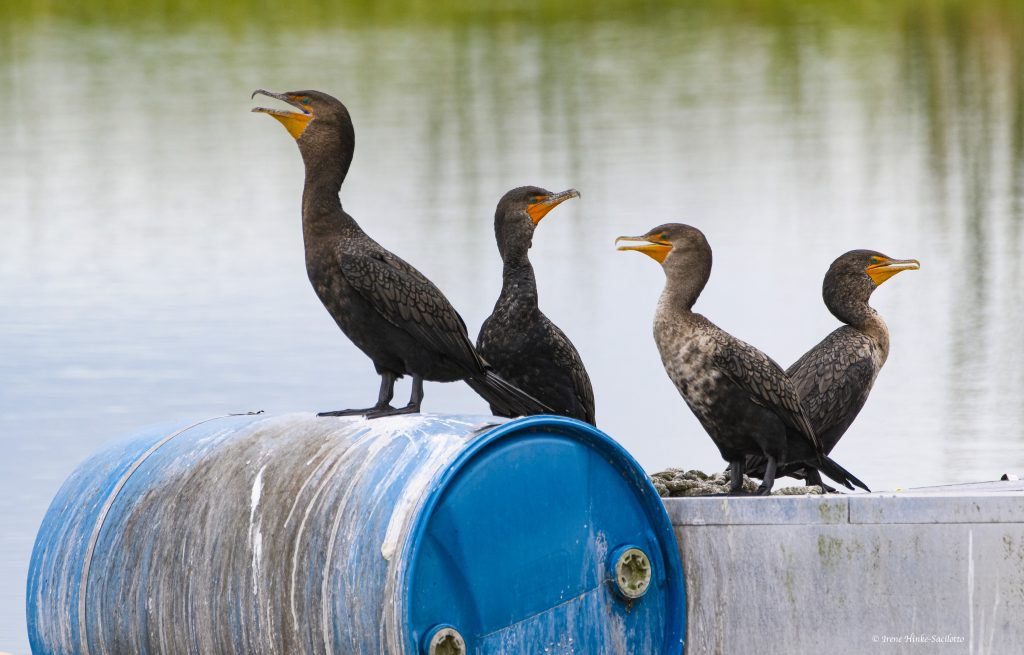
Double-crested Cormorant at Blue Heron Wetlands Facility
In the case of Orlando Wetlands, you can walk along the extensive series of dike roads. At certain times, you can take a tram tour of the facility. In the case of Blue Heron Water Reclamation Wetland Area, you must sign-in & out at their administrative office on site. When I was there, you could drive selected dike roads that provided great opportunities for photography with animals at close range and use to human presence. However, for all locations that I mention in this and the following newsletter, you must check current conditions and regulations.
A number of images in this newsletter are labeled with the location where they were taken. I first visited Orlando Wetlands about a half hour from Titusville. I walked along the dike roads expecting wildlife to be far away and intolerant of my presences. I was pleasantly surprised that many animals just ignored me and went about their normal activities. Alligators, limpkins, ibis, egrets, gallinules, and sandhill cranes were within easy camera range for photography. After conducting several December photo workshops at Bosque del Apache National Wildlife Refuge where thousands of sandhill cranes spend their time from mid-November to mid-February, I was surprised to see several cranes feeding in the first field I encountered. These Florida Sandhill Cranes are resident birds that nest in Florida and don’t migrate. They are omnivorous eating seeds, insects, frogs, mice and other organisms abundant in the marsh. Near Viera Wetlands, I actually saw a crane feeding in someone’s front lawn in the middle of a development. Later I discovered that they can be found on golf courses, parks, and in other public places.

Wood Stork sitting on branch at Orlando Wetland.
To visit Blue Heron Wetlands on weekends, you must make prior arrangements. In general many of the locations I visited were closed on certain days of the week. Those providing early entry for photographers who have purchased photo passes, such as St. Augustine’s Alligator Farm and Gator World’s rookery near Orlando, limit this privilege to certain days of the week or particular months, unfortunate for me February was not included. It is critical to check each location before visiting for rules, open dates, and conditions. For example, a favorite of many photographers, Green Cay Wetlands was closed to visitation due to renovations starting in November 2019. I had visited it several years ago and was impressed with its long boardwalk and large population of nesting birds.

Great Blue Heron at Blue Heron Reclamation Wetlands exposing underside of wings.
In following newsletters, I will cover Merritt Island National Wildlife Refuge and Cape Canaveral National Seashore plus several other areas along Florida’s east coast. The pelican/spoonbill photo at the opening of this newsletter was shot on Merritt Island one morning during my recent visit.

Great Blue Heron resting at Blue Heron Reclamation Facility.

Great Blue Heron at Blue Heron Reclamation Facility.

Red-shouldered Hawk perched in tree on Blue Heron Reclamation Wetland.
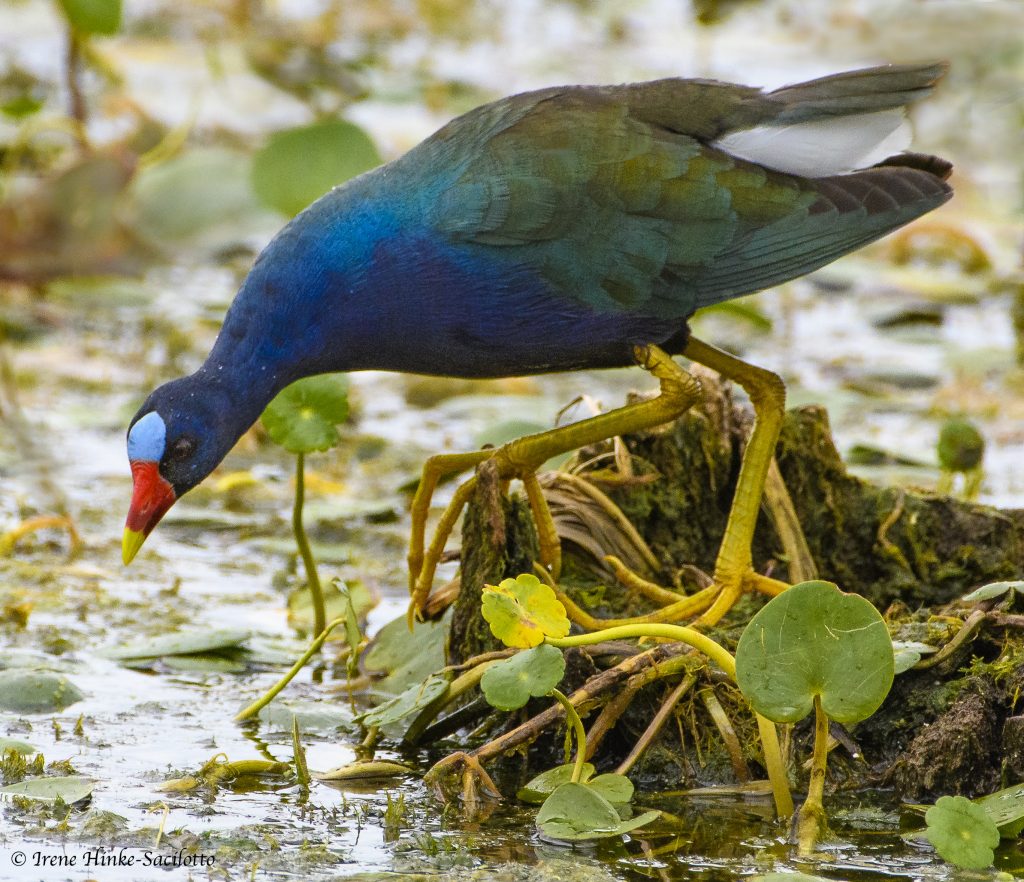
Purple Gallinule Feeding ay Blue Heron Reclamation Wetlands.
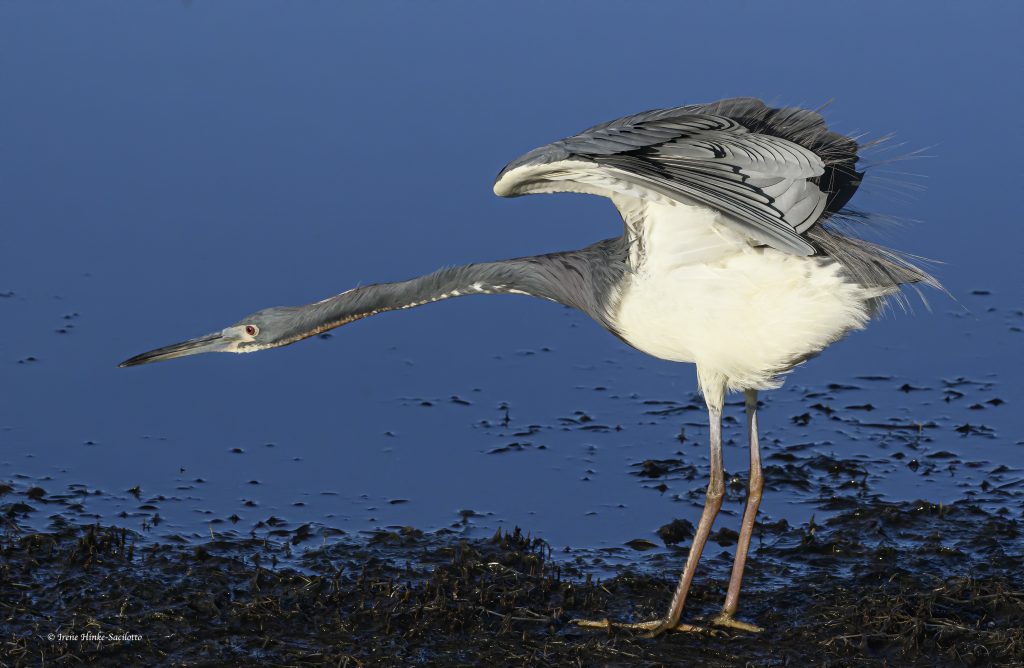
Tricolor Heron stretching on Merritt Island NWR Subject of next blog.

White Pelicans and Spoonbills at Merritt Island NWR.




















































 x
x










































